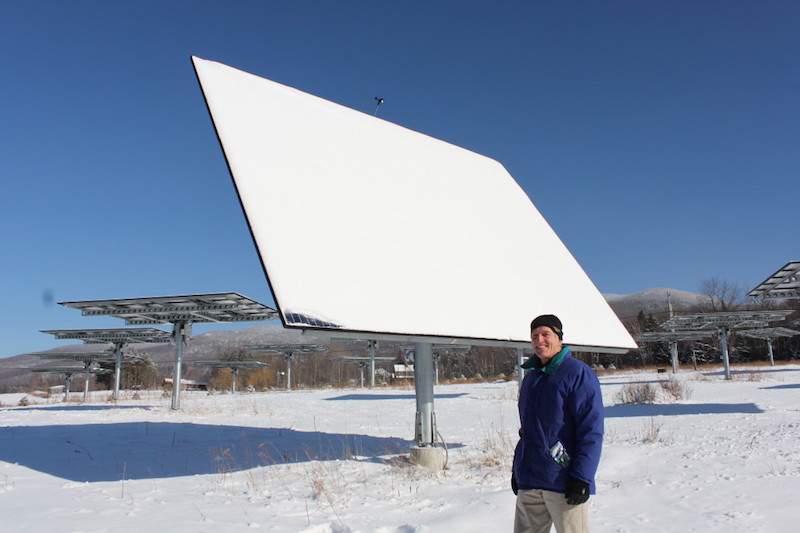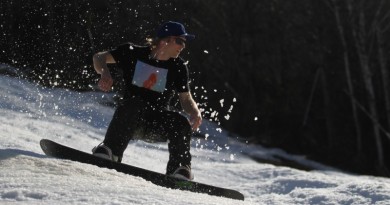Vermont Resorts Soften Expansions with Efficiency Projects

Many Vermonters are concerned about the environment. We talk about the resorts striving for sustainability and efficiency while they expand capacity.
by Evan Johnson
From new hotels to slopes lined with new snowguns, resorts have increased in both output and capacity in recent years. This winter has been a major season for resort expansions, and thanks to solar panels, windmills, incentives from nonprofits and big piles of compost, resorts are able to keep the bills for electricity and water low, while at the same time increasing capacity.
At Mount Snow Resort, a recently released case study showed that a 2,500 light fixture upgrade in the Grand Summit Hotel will save 419,773-kilowatt hours annually – a total of $39,126 in electricity costs. In total, efficiency measures resort-wide in 2013 will save 1,063,797-kilowatt hours annually or about 6.4 percent of Mount Snow’s 2012 electric use.
“Usually when you make a car more efficient, you sacrifice horsepower,” says Dave Meeker, Communications Manager for Mount Snow. “But here that’s really not the case.”
Chuck Clerici, an account manager with Efficiency Vermont, a nonprofit that helps individuals and small businesses improve energy efficiency in existing buildings and new developments, says that as older buildings become due for upgrades and renovations, efficient options are the logical choice.
“A lot of the mountains are saddled with older properties that weren’t built at a time when energy management was very important,” he says. “They’re leaky, not well insulated and use old motors. It doesn’t necessarily pay to replace it.”
As a result of their work, Mount Snow has been nominated this year by Efficiency Vermont for a Northeast Energy Efficiency Partnership award (NEEP), which recognizes “business leaders for energy efficiency.”
And of course, Mount Snow isn’t alone. The Stowe Mountain Lodge received Audubon International’s Green Leaf certification in 2009 as well as Audubon’s Green Community award for the lodge’s Spruce Peak at Stowe village, and the Audubon International Signature Sanctuary certification for the resort’s Stowe Mountain Golf Club course. In 2010 Stowe Mountain Lodge was awarded 5 Green Keys – the maximum rating – by Green Key Global.
Sugarbush received a Governor’s Award in 2012 for cleanup efforts of Rice Brook, a tributary of the Mad River that had been contaminated by stormwater runoff. The brook was removed from the state’s list of impaired waters.
Smugglers’ Notch was awarded the Green Mountain Awards for Environmental Excellence in 2013 and was the first resort in Vermont to be designated as an “environmental leader” by the Vermont Department of Environmental Conservation.
MONITORING THE WASTE
At Sugarbush Resort, Margo Wade, Director of Planning and Regulatory Compliance, says much of the resort’s projects at the base lodge and Sugarbush Inn have centered on diverting as much waste as possible from the landfill. Sugarbush has diverted 35 percent of its waste by composting, recycling or separating the waste the resort produces. Food services has been able to compost roughly 12 tons of food scraps every year, a number she says is conservative as some employees are able to take home food scraps to feed to pigs or contribute to their own compost piles. Other food scraps are composted and used in landscaping. While it costs $140 per-ton to send garbage to the landfill, recycling is able to save $95 on every ton.
When the Stowe Mountain Lodge opened in 2005, recycling programs were diverting 70 percent of waste from the landfill. Today, the lodge sends compostable waste to Grow Compost in Moretown, which produces compost adhering to Northeast Organic Farming Association (NOFA) standards.
Andre Blais, Projects Manager at the Lodge, says being a hotel makes it easier to follow-through on this and other projects and points to the food service as an example. When producing a meal, waste from producing the meal (peels, husks, pits, bones, etc.) as well as uneaten food scraps, are placed in the compost. The staff fully controls the waste and can ensure it goes through the proper channels. Control is good, but he recognizes they can’t be everywhere all of the time.
“On the other hand, we’re not in the room with them to make sure they put something in the right bin,” he admits.
NEW TECHNOLOGY, BIG SAVINGS
Cutting costs goes well beyond sorting trash. Aside from managing their waste stream, The Stowe Mountain Lodge monitors the energy usage and performance of every piece of machinery in every one of its 300 rooms. Every fan, valve, coil and pipe can be monitored for damage or wear from a single computer with the help of programs from Trane Systems and Vermont Temperature Controls. Blais says the system helps save not only energy, but also the staff’s time; with these two systems, they can know exactly which appliances need maintenance and which parts need to be replaced.
New expansion projects have demonstrated fast returns on investment. When Smuggler’s Notch began designs for a new daycare center in 2002, the resort consulted with Efficiency Vermont, which provided over $4,000 in incentives to offset the cost of heating, cooling and lighting systems. It took just over a year to recoup the initial investment and the project has saved $2,280 every year in electricity costs. Over the course of the structure’s lifetime, Efficiency Vermont estimates the measures will save $44,500.
Bolton Valley constructed the first wind turbine at a Vermont ski area in 2009 at a cost of over $800,000. It was projected to produce in excess of over 300,000 kilowatt-hours annually, or the same power used by 45 Vermont households. Every year, the windmill has saved over $70,000 every year in electricity costs.
One of the larger endeavors at Smugglers’ Notch was the installation of 35 solar trackers near the resort. The installation was completed in 2012 as a test before the company producing the trackers went out of business. In the first year, the array produced 200,000 kilowatt hours of electricity their first year, exceeding original estimates. Today, Smugglers’ purchases the produced electricity under a lease from All Earth Services and in five years, will have the opportunity to purchase the array. Dan Maxon, Planning and Permitting Manager, anticipates it will take six to eight years to recoup the investment while producing up to $50,000 worth of electricity every year. The payoff, he says, is a means to avoid electricity costs in the future.
“This power, in effect, pays-off commercial and overhead costs,” he says. “If we can save $50,000 a year on electricity, that’s $50,000 less we have to build into our price structure. When you pay for a lift ticket, you’re paying for some of our overhead.”
MOVING FORWARD
This past September, the state green-lighted a $200 million development at Okemo Mountain Resort. In January, plans were recently unveiled at Mount Snow for an EB-5 immigrant investor project including the construction of a new storage reservoir for snowmaking with capacity of up to 120 million gallons, three new pump houses and the installation of new pipelines and trail upgrades as well as a 36,000-square-foot base lodge at the Carinthia base area. Progress on Jay Peak Resort’s own EB-5 project continues. Big things are in store and with all these developments and expansions planned or in-progress, Chuck Clerici at Efficiency Vermont says it’s still possible for resorts to maintain commitments to environmental stewardship. The secret, he says, is for developers to put in little more effort and investment early on that will pay off in the future.
“You’re going to have to put lighting in these buildings,” he says. “Are you going to put in the base package that barely meets code? Or are you going to go an extra step or two with project efficiency, determine the return on investment and justify spending little more on your lighting up front so that it doesn’t cost as much over time?”
By shrinking the energy bill, resorts can spend money on things that actually draw more people, like snowmaking or improved terrain. Alan Herbert, also an account manager at Efficiency Vermont, says new developments will expand the size and health of one of the largest sectors of the Vermont economy.
“The ski industry plays a big role in the economy of the state of Vermont, bringing in millions of dollars every year,” he says. “If we can help them be more sustainable both environmentally and economically, that’s going to help drive the economy and the money they bring into the state.”
And in order to maximize the guests’ experience and maintain those high efficiency standards, Andre Blais at the Stowe Mountain Lodge says the way forward is to include the guests as much as possible.
“There’s no carrot,” he says. “You don’t get a free room for a night if you choose to recycle. But by offering the opportunity and then educating them that the opportunity is there, that’s two steps you’ve taken towards helping them make the decision to do the right thing.”

